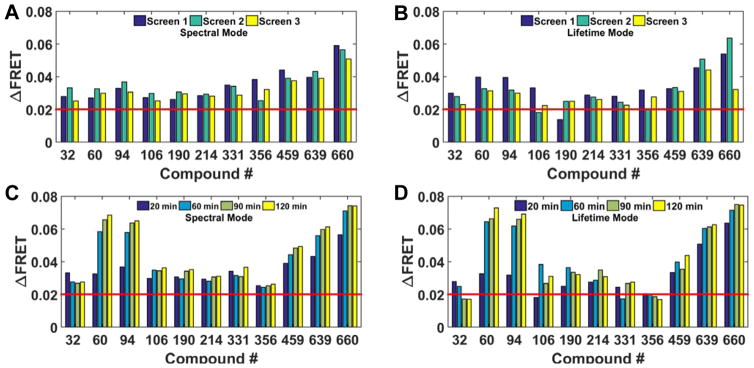Figure 4.
Reproducible FRET hits assessed across independent screens and time course studies. (A) Spectral mode identified eleven reproducible 2CS FRET hits using a threshold of 0.02 change in FRET (red line). The reproducibility of each 2CS FRET hit, after 20 min incubation, across three independent screens is shown. The ΔFRET from each compound remains consistent from screen to screen. ΔFRET was calculated by assessing the change in FRET of 2CS from the average FRET, determined by the Gaussian fit of all wells not flagged as fluorescence compounds. (B) Lifetime mode assessment of the eleven reproducible spectral FRET hits. Nine of the eleven FRET hits were reproducible (triplicate) hits using a 0.02 FRET threshold. Compounds #106 and190 were not identified as lifetime FRET hits in one of the three independent screens. (C) Spectral FRET hits evaluated by time-course studies. Each independent pilot screen was scanned in spectral mode after 20, 60, 90, and 120 minutes of compound incubation. The change in 2CS FRET efficiency (ΔFRET) of each compound is plotted and each reproducible FRET hit, identified as a hit using the spectral unmixing method, remained a hit over multiple time points. The 2CS FRET hits depicted here were from screen 2 (turquoise bars in A and B). Compounds #60, 94, 459, 639, and 660 exhibited an increased FRET change over time. (D) Lifetime FRET change evaluated by time-course studies. Ten compounds from screen 2 were identified as hits, after 20 minutes of compound incubation, using a threshold set at 0.02 FRET change (red bar). Compounds #32 and 356 displayed a modest reduction in 2CS ΔFRET at the later time points. Compounds # 60, 94, 459, 639, and 660 again exhibited an increased FRET change over time.

